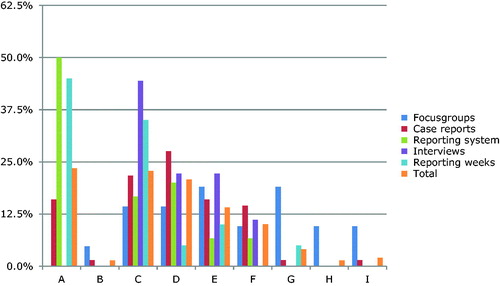Figures & data
Table 1. Flowchart of data sources and number of reported TSIs by patients and healthcare professionals.
Figure 1. Classification by severity of transitional safety incidents according to NCC-MERP index. Category A: unsafe situation (no error); these concern events that have the capacity to cause error. Category B: near miss (error, no harm); an error occurred but did not reach the patient. Category C: near miss (error, no harm); an error occurred that reached the patient but no harm was caused. Category D: near miss (error, no harm); an error occurred, reached the patient and required monitoring/intervention to preclude harm. Category E: adverse event (error and harm); error that may have contributed/resulted in temporary harm and required intervention. Category F: adverse event (error and harm); error that may have contributed to or resulted in temporary harm and required initial or prolonged hospitalization. Category G: adverse event (error and harm); error that may have contributed to or resulted in permanent harm. Category H: adverse event (error and harm); error that required intervention necessary to sustain life. Category I: adverse event (error and death); error that may have contributed to or resulted in patient’s death.

Table 2. Classification of 368 of 548 TSIs into aspects of the care transition process, stratified per data source.
Table 3. Classification of 368 of 548 TSIs into aspects of care transition process, stratified for patients and healthcare providers.
Table 4. Classification of 191 of 548 TSIs by cause according to the Eindhoven Classification Model (ECM), stratified for the different data sources.
